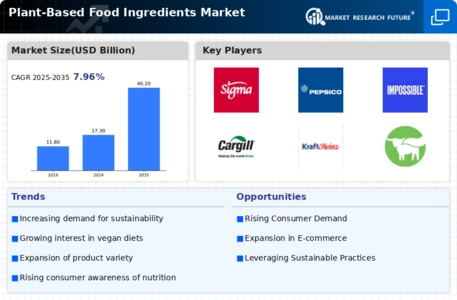Proteins
Fiber
Starch
Fats and Oils
Emulsifiers
Fruits
Vegetables
Legumes
Grains
Nuts and Seeds
Food and Beverages
Nutritional Supplements
Animal Feed
Cosmetics
Pharmaceuticals
Retail
Food Service
Food Processing
Industrial
North America
Europe
South America
Asia Pacific
Middle East and Africa
North America Outlook (USD Billion, 2019-2035)
North America Plant-Based Food Ingredients Market by Ingredient Type
Proteins
Fiber
Starch
Fats and Oils
Emulsifiers
North America Plant-Based Food Ingredients Market by Source Type
Fruits
Vegetables
Legumes
Grains
Nuts and Seeds
North America Plant-Based Food Ingredients Market by Application Type
Food and Beverages
Nutritional Supplements
Animal Feed
Cosmetics
Pharmaceuticals
North America Plant-Based Food Ingredients Market by End Use Type
Retail
Food Service
Food Processing
Industrial
North America Plant-Based Food Ingredients Market by Regional Type
US
Canada
US Outlook (USD Billion, 2019-2035)
US Plant-Based Food Ingredients Market by Ingredient Type
Proteins
Fiber
Starch
Fats and Oils
Emulsifiers
US Plant-Based Food Ingredients Market by Source Type
Fruits
Vegetables
Legumes
Grains
Nuts and Seeds
US Plant-Based Food Ingredients Market by Application Type
Food and Beverages
Nutritional Supplements
Animal Feed
Cosmetics
Pharmaceuticals
US Plant-Based Food Ingredients Market by End Use Type
Retail
Food Service
Food Processing
Industrial
CANADA Outlook (USD Billion, 2019-2035)
CANADA Plant-Based Food Ingredients Market by Ingredient Type
Proteins
Fiber
Starch
Fats and Oils
Emulsifiers
CANADA Plant-Based Food Ingredients Market by Source Type
Fruits
Vegetables
Legumes
Grains
Nuts and Seeds
CANADA Plant-Based Food Ingredients Market by Application Type
Food and Beverages
Nutritional Supplements
Animal Feed
Cosmetics
Pharmaceuticals
CANADA Plant-Based Food Ingredients Market by End Use Type
Retail
Food Service
Food Processing
Industrial
Europe Outlook (USD Billion, 2019-2035)
Europe Plant-Based Food Ingredients Market by Ingredient Type
Proteins
Fiber
Starch
Fats and Oils
Emulsifiers
Europe Plant-Based Food Ingredients Market by Source Type
Fruits
Vegetables
Legumes
Grains
Nuts and Seeds
Europe Plant-Based Food Ingredients Market by Application Type
Food and Beverages
Nutritional Supplements
Animal Feed
Cosmetics
Pharmaceuticals
Europe Plant-Based Food Ingredients Market by End Use Type
Retail
Food Service
Food Processing
Industrial
Europe Plant-Based Food Ingredients Market by Regional Type
Germany
UK
France
Russia
Italy
Spain
Rest of Europe
GERMANY Outlook (USD Billion, 2019-2035)
GERMANY Plant-Based Food Ingredients Market by Ingredient Type
Proteins
Fiber
Starch
Fats and Oils
Emulsifiers
GERMANY Plant-Based Food Ingredients Market by Source Type
Fruits
Vegetables
Legumes
Grains
Nuts and Seeds
GERMANY Plant-Based Food Ingredients Market by Application Type
Food and Beverages
Nutritional Supplements
Animal Feed
Cosmetics
Pharmaceuticals
GERMANY Plant-Based Food Ingredients Market by End Use Type
Retail
Food Service
Food Processing
Industrial
UK Outlook (USD Billion, 2019-2035)
UK Plant-Based Food Ingredients Market by Ingredient Type
Proteins
Fiber
Starch
Fats and Oils
Emulsifiers
UK Plant-Based Food Ingredients Market by Source Type
Fruits
Vegetables
Legumes
Grains
Nuts and Seeds
UK Plant-Based Food Ingredients Market by Application Type
Food and Beverages
Nutritional Supplements
Animal Feed
Cosmetics
Pharmaceuticals
UK Plant-Based Food Ingredients Market by End Use Type
Retail
Food Service
Food Processing
Industrial
FRANCE Outlook (USD Billion, 2019-2035)
FRANCE Plant-Based Food Ingredients Market by Ingredient Type
Proteins
Fiber
Starch
Fats and Oils
Emulsifiers
FRANCE Plant-Based Food Ingredients Market by Source Type
Fruits
Vegetables
Legumes
Grains
Nuts and Seeds
FRANCE Plant-Based Food Ingredients Market by Application Type
Food and Beverages
Nutritional Supplements
Animal Feed
Cosmetics
Pharmaceuticals
FRANCE Plant-Based Food Ingredients Market by End Use Type
Retail
Food Service
Food Processing
Industrial
RUSSIA Outlook (USD Billion, 2019-2035)
RUSSIA Plant-Based Food Ingredients Market by Ingredient Type
Proteins
Fiber
Starch
Fats and Oils
Emulsifiers
RUSSIA Plant-Based Food Ingredients Market by Source Type
Fruits
Vegetables
Legumes
Grains
Nuts and Seeds
RUSSIA Plant-Based Food Ingredients Market by Application Type
Food and Beverages
Nutritional Supplements
Animal Feed
Cosmetics
Pharmaceuticals
RUSSIA Plant-Based Food Ingredients Market by End Use Type
Retail
Food Service
Food Processing
Industrial
ITALY Outlook (USD Billion, 2019-2035)
ITALY Plant-Based Food Ingredients Market by Ingredient Type
Proteins
Fiber
Starch
Fats and Oils
Emulsifiers
ITALY Plant-Based Food Ingredients Market by Source Type
Fruits
Vegetables
Legumes
Grains
Nuts and Seeds
ITALY Plant-Based Food Ingredients Market by Application Type
Food and Beverages
Nutritional Supplements
Animal Feed
Cosmetics
Pharmaceuticals
ITALY Plant-Based Food Ingredients Market by End Use Type
Retail
Food Service
Food Processing
Industrial
SPAIN Outlook (USD Billion, 2019-2035)
SPAIN Plant-Based Food Ingredients Market by Ingredient Type
Proteins
Fiber
Starch
Fats and Oils
Emulsifiers
SPAIN Plant-Based Food Ingredients Market by Source Type
Fruits
Vegetables
Legumes
Grains
Nuts and Seeds
SPAIN Plant-Based Food Ingredients Market by Application Type
Food and Beverages
Nutritional Supplements
Animal Feed
Cosmetics
Pharmaceuticals
SPAIN Plant-Based Food Ingredients Market by End Use Type
Retail
Food Service
Food Processing
Industrial
REST OF EUROPE Outlook (USD Billion, 2019-2035)
REST OF EUROPE Plant-Based Food Ingredients Market by Ingredient Type
Proteins
Fiber
Starch
Fats and Oils
Emulsifiers
REST OF EUROPE Plant-Based Food Ingredients Market by Source Type
Fruits
Vegetables
Legumes
Grains
Nuts and Seeds
REST OF EUROPE Plant-Based Food Ingredients Market by Application Type
Food and Beverages
Nutritional Supplements
Animal Feed
Cosmetics
Pharmaceuticals
REST OF EUROPE Plant-Based Food Ingredients Market by End Use Type
Retail
Food Service
Food Processing
Industrial
APAC Outlook (USD Billion, 2019-2035)
APAC Plant-Based Food Ingredients Market by Ingredient Type
Proteins
Fiber
Starch
Fats and Oils
Emulsifiers
APAC Plant-Based Food Ingredients Market by Source Type
Fruits
Vegetables
Legumes
Grains
Nuts and Seeds
APAC Plant-Based Food Ingredients Market by Application Type
Food and Beverages
Nutritional Supplements
Animal Feed
Cosmetics
Pharmaceuticals
APAC Plant-Based Food Ingredients Market by End Use Type
Retail
Food Service
Food Processing
Industrial
APAC Plant-Based Food Ingredients Market by Regional Type
China
India
Japan
South Korea
Malaysia
Thailand
Indonesia
Rest of APAC
CHINA Outlook (USD Billion, 2019-2035)
CHINA Plant-Based Food Ingredients Market by Ingredient Type
Proteins
Fiber
Starch
Fats and Oils
Emulsifiers
CHINA Plant-Based Food Ingredients Market by Source Type
Fruits
Vegetables
Legumes
Grains
Nuts and Seeds
CHINA Plant-Based Food Ingredients Market by Application Type
Food and Beverages
Nutritional Supplements
Animal Feed
Cosmetics
Pharmaceuticals
CHINA Plant-Based Food Ingredients Market by End Use Type
Retail
Food Service
Food Processing
Industrial
INDIA Outlook (USD Billion, 2019-2035)
INDIA Plant-Based Food Ingredients Market by Ingredient Type
Proteins
Fiber
Starch
Fats and Oils
Emulsifiers
INDIA Plant-Based Food Ingredients Market by Source Type
Fruits
Vegetables
Legumes
Grains
Nuts and Seeds
INDIA Plant-Based Food Ingredients Market by Application Type
Food and Beverages
Nutritional Supplements
Animal Feed
Cosmetics
Pharmaceuticals
INDIA Plant-Based Food Ingredients Market by End Use Type
Retail
Food Service
Food Processing
Industrial
JAPAN Outlook (USD Billion, 2019-2035)
JAPAN Plant-Based Food Ingredients Market by Ingredient Type
Proteins
Fiber
Starch
Fats and Oils
Emulsifiers
JAPAN Plant-Based Food Ingredients Market by Source Type
Fruits
Vegetables
Legumes
Grains
Nuts and Seeds
JAPAN Plant-Based Food Ingredients Market by Application Type
Food and Beverages
Nutritional Supplements
Animal Feed
Cosmetics
Pharmaceuticals
JAPAN Plant-Based Food Ingredients Market by End Use Type
Retail
Food Service
Food Processing
Industrial
SOUTH KOREA Outlook (USD Billion, 2019-2035)
SOUTH KOREA Plant-Based Food Ingredients Market by Ingredient Type
Proteins
Fiber
Starch
Fats and Oils
Emulsifiers
SOUTH KOREA Plant-Based Food Ingredients Market by Source Type
Fruits
Vegetables
Legumes
Grains
Nuts and Seeds
SOUTH KOREA Plant-Based Food Ingredients Market by Application Type
Food and Beverages
Nutritional Supplements
Animal Feed
Cosmetics
Pharmaceuticals
SOUTH KOREA Plant-Based Food Ingredients Market by End Use Type
Retail
Food Service
Food Processing
Industrial
MALAYSIA Outlook (USD Billion, 2019-2035)
MALAYSIA Plant-Based Food Ingredients Market by Ingredient Type
Proteins
Fiber
Starch
Fats and Oils
Emulsifiers
MALAYSIA Plant-Based Food Ingredients Market by Source Type
Fruits
Vegetables
Legumes
Grains
Nuts and Seeds
MALAYSIA Plant-Based Food Ingredients Market by Application Type
Food and Beverages
Nutritional Supplements
Animal Feed
Cosmetics
Pharmaceuticals
MALAYSIA Plant-Based Food Ingredients Market by End Use Type
Retail
Food Service
Food Processing
Industrial
THAILAND Outlook (USD Billion, 2019-2035)
THAILAND Plant-Based Food Ingredients Market by Ingredient Type
Proteins
Fiber
Starch
Fats and Oils
Emulsifiers
THAILAND Plant-Based Food Ingredients Market by Source Type
Fruits
Vegetables
Legumes
Grains
Nuts and Seeds
THAILAND Plant-Based Food Ingredients Market by Application Type
Food and Beverages
Nutritional Supplements
Animal Feed
Cosmetics
Pharmaceuticals
THAILAND Plant-Based Food Ingredients Market by End Use Type
Retail
Food Service
Food Processing
Industrial
INDONESIA Outlook (USD Billion, 2019-2035)
INDONESIA Plant-Based Food Ingredients Market by Ingredient Type
Proteins
Fiber
Starch
Fats and Oils
Emulsifiers
INDONESIA Plant-Based Food Ingredients Market by Source Type
Fruits
Vegetables
Legumes
Grains
Nuts and Seeds
INDONESIA Plant-Based Food Ingredients Market by Application Type
Food and Beverages
Nutritional Supplements
Animal Feed
Cosmetics
Pharmaceuticals
INDONESIA Plant-Based Food Ingredients Market by End Use Type
Retail
Food Service
Food Processing
Industrial
REST OF APAC Outlook (USD Billion, 2019-2035)
REST OF APAC Plant-Based Food Ingredients Market by Ingredient Type
Proteins
Fiber
Starch
Fats and Oils
Emulsifiers
REST OF APAC Plant-Based Food Ingredients Market by Source Type
Fruits
Vegetables
Legumes
Grains
Nuts and Seeds
REST OF APAC Plant-Based Food Ingredients Market by Application Type
Food and Beverages
Nutritional Supplements
Animal Feed
Cosmetics
Pharmaceuticals
REST OF APAC Plant-Based Food Ingredients Market by End Use Type
Retail
Food Service
Food Processing
Industrial
South America Outlook (USD Billion, 2019-2035)
South America Plant-Based Food Ingredients Market by Ingredient Type
Proteins
Fiber
Starch
Fats and Oils
Emulsifiers
South America Plant-Based Food Ingredients Market by Source Type
Fruits
Vegetables
Legumes
Grains
Nuts and Seeds
South America Plant-Based Food Ingredients Market by Application Type
Food and Beverages
Nutritional Supplements
Animal Feed
Cosmetics
Pharmaceuticals
South America Plant-Based Food Ingredients Market by End Use Type
Retail
Food Service
Food Processing
Industrial
South America Plant-Based Food Ingredients Market by Regional Type
Brazil
Mexico
Argentina
Rest of South America
BRAZIL Outlook (USD Billion, 2019-2035)
BRAZIL Plant-Based Food Ingredients Market by Ingredient Type
Proteins
Fiber
Starch
Fats and Oils
Emulsifiers
BRAZIL Plant-Based Food Ingredients Market by Source Type
Fruits
Vegetables
Legumes
Grains
Nuts and Seeds
BRAZIL Plant-Based Food Ingredients Market by Application Type
Food and Beverages
Nutritional Supplements
Animal Feed
Cosmetics
Pharmaceuticals
BRAZIL Plant-Based Food Ingredients Market by End Use Type
Retail
Food Service
Food Processing
Industrial
MEXICO Outlook (USD Billion, 2019-2035)
MEXICO Plant-Based Food Ingredients Market by Ingredient Type
Proteins
Fiber
Starch
Fats and Oils
Emulsifiers
MEXICO Plant-Based Food Ingredients Market by Source Type
Fruits
Vegetables
Legumes
Grains
Nuts and Seeds
MEXICO Plant-Based Food Ingredients Market by Application Type
Food and Beverages
Nutritional Supplements
Animal Feed
Cosmetics
Pharmaceuticals
MEXICO Plant-Based Food Ingredients Market by End Use Type
Retail
Food Service
Food Processing
Industrial
ARGENTINA Outlook (USD Billion, 2019-2035)
ARGENTINA Plant-Based Food Ingredients Market by Ingredient Type
Proteins
Fiber
Starch
Fats and Oils
Emulsifiers
ARGENTINA Plant-Based Food Ingredients Market by Source Type
Fruits
Vegetables
Legumes
Grains
Nuts and Seeds
ARGENTINA Plant-Based Food Ingredients Market by Application Type
Food and Beverages
Nutritional Supplements
Animal Feed
Cosmetics
Pharmaceuticals
ARGENTINA Plant-Based Food Ingredients Market by End Use Type
Retail
Food Service
Food Processing
Industrial
REST OF SOUTH AMERICA Outlook (USD Billion, 2019-2035)
REST OF SOUTH AMERICA Plant-Based Food Ingredients Market by Ingredient Type
Proteins
Fiber
Starch
Fats and Oils
Emulsifiers
REST OF SOUTH AMERICA Plant-Based Food Ingredients Market by Source Type
Fruits
Vegetables
Legumes
Grains
Nuts and Seeds
REST OF SOUTH AMERICA Plant-Based Food Ingredients Market by Application Type
Food and Beverages
Nutritional Supplements
Animal Feed
Cosmetics
Pharmaceuticals
REST OF SOUTH AMERICA Plant-Based Food Ingredients Market by End Use Type
Retail
Food Service
Food Processing
Industrial
MEA Outlook (USD Billion, 2019-2035)
MEA Plant-Based Food Ingredients Market by Ingredient Type
Proteins
Fiber
Starch
Fats and Oils
Emulsifiers
MEA Plant-Based Food Ingredients Market by Source Type
Fruits
Vegetables
Legumes
Grains
Nuts and Seeds
MEA Plant-Based Food Ingredients Market by Application Type
Food and Beverages
Nutritional Supplements
Animal Feed
Cosmetics
Pharmaceuticals
MEA Plant-Based Food Ingredients Market by End Use Type
Retail
Food Service
Food Processing
Industrial
MEA Plant-Based Food Ingredients Market by Regional Type
GCC Countries
South Africa
Rest of MEA
GCC COUNTRIES Outlook (USD Billion, 2019-2035)
GCC COUNTRIES Plant-Based Food Ingredients Market by Ingredient Type
Proteins
Fiber
Starch
Fats and Oils
Emulsifiers
GCC COUNTRIES Plant-Based Food Ingredients Market by Source Type
Fruits
Vegetables
Legumes
Grains
Nuts and Seeds
GCC COUNTRIES Plant-Based Food Ingredients Market by Application Type
Food and Beverages
Nutritional Supplements
Animal Feed
Cosmetics
Pharmaceuticals
GCC COUNTRIES Plant-Based Food Ingredients Market by End Use Type
Retail
Food Service
Food Processing
Industrial
SOUTH AFRICA Outlook (USD Billion, 2019-2035)
SOUTH AFRICA Plant-Based Food Ingredients Market by Ingredient Type
Proteins
Fiber
Starch
Fats and Oils
Emulsifiers
SOUTH AFRICA Plant-Based Food Ingredients Market by Source Type
Fruits
Vegetables
Legumes
Grains
Nuts and Seeds
SOUTH AFRICA Plant-Based Food Ingredients Market by Application Type
Food and Beverages
Nutritional Supplements
Animal Feed
Cosmetics
Pharmaceuticals
SOUTH AFRICA Plant-Based Food Ingredients Market by End Use Type
Retail
Food Service
Food Processing
Industrial
REST OF MEA Outlook (USD Billion, 2019-2035)
REST OF MEA Plant-Based Food Ingredients Market by Ingredient Type
Proteins
Fiber
Starch
Fats and Oils
Emulsifiers
REST OF MEA Plant-Based Food Ingredients Market by Source Type
Fruits
Vegetables
Legumes
Grains
Nuts and Seeds
REST OF MEA Plant-Based Food Ingredients Market by Application Type
Food and Beverages
Nutritional Supplements
Animal Feed
Cosmetics
Pharmaceuticals
REST OF MEA Plant-Based Food Ingredients Market by End Use Type
Retail
Food Service
Food Processing
Industrial

















Leave a Comment